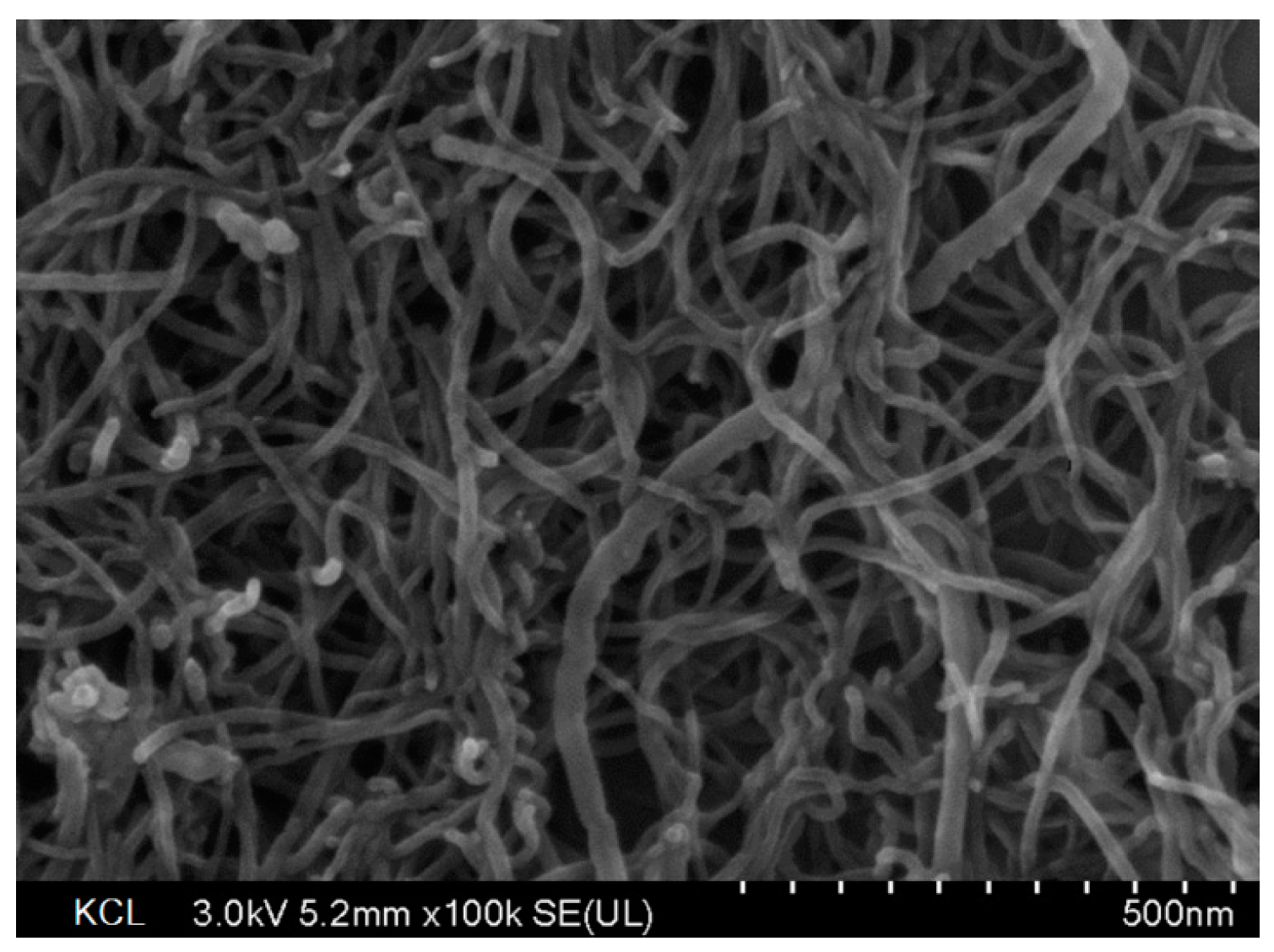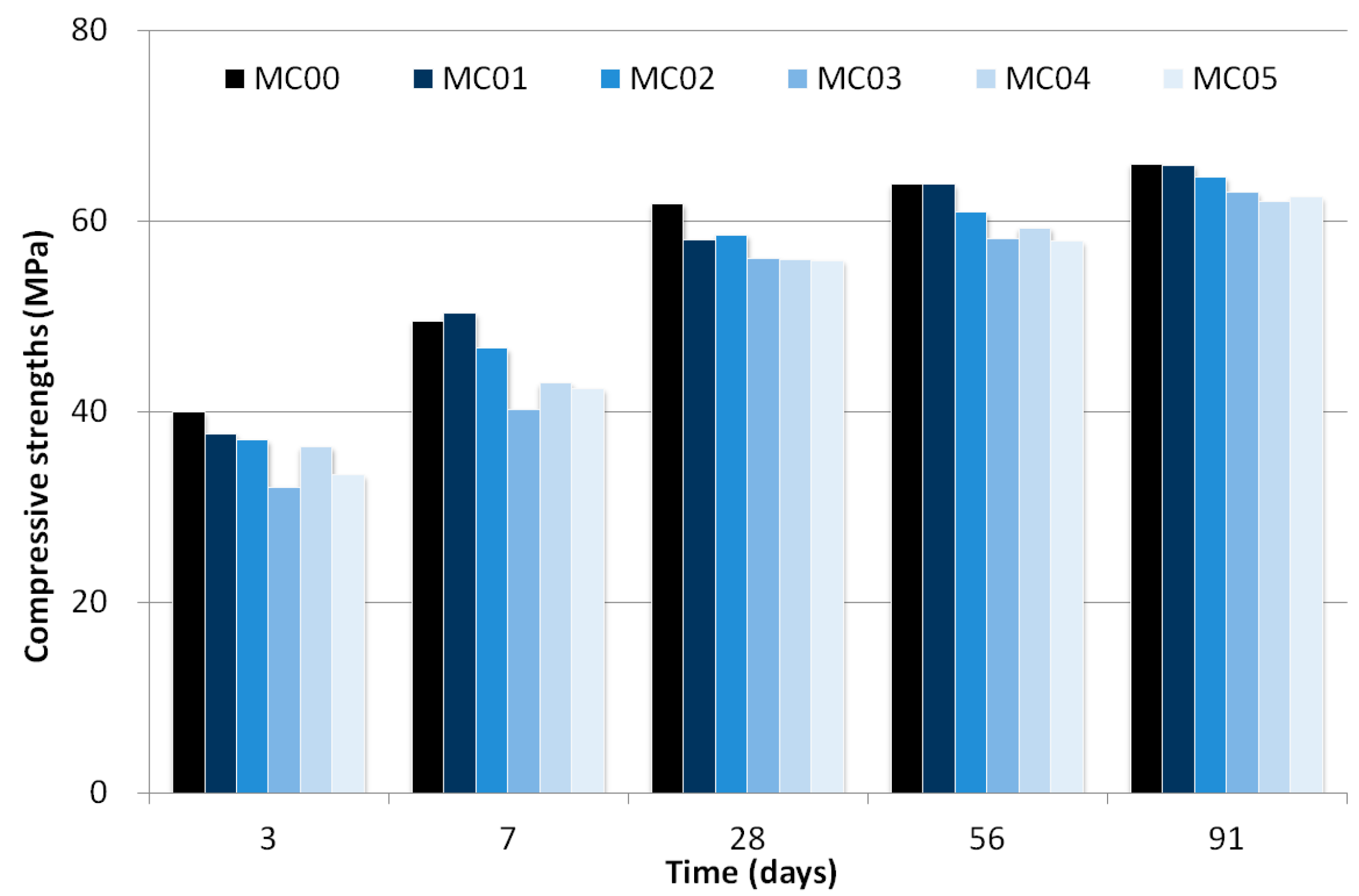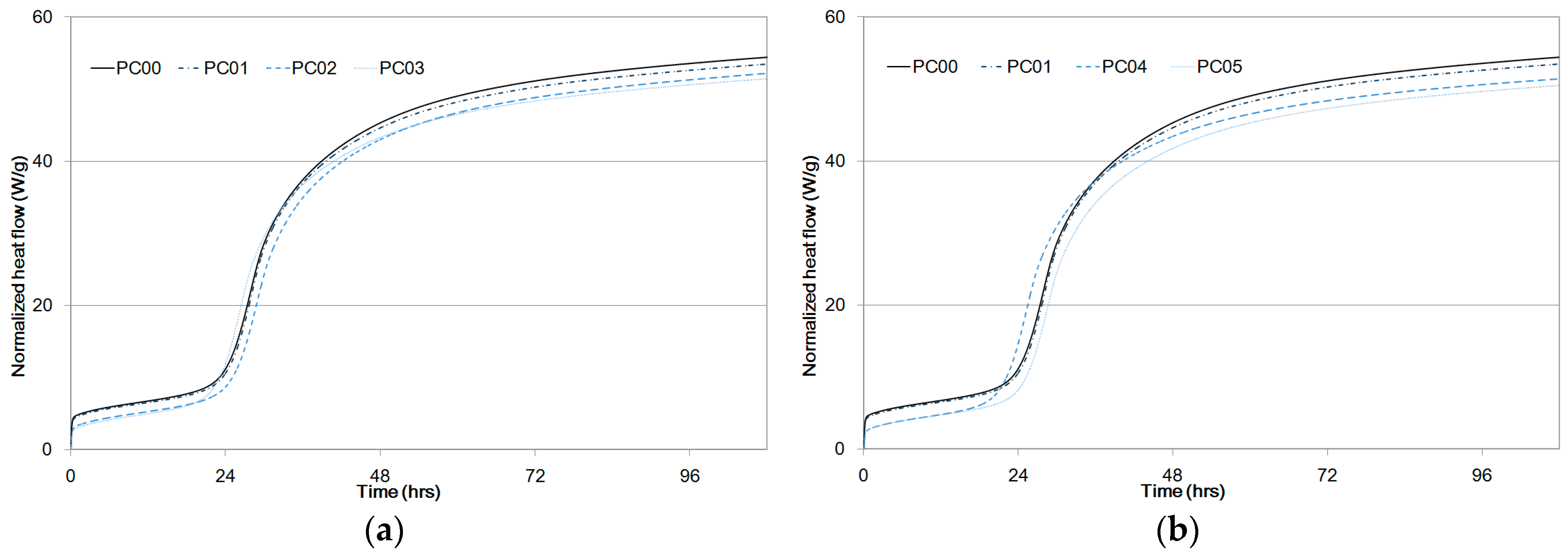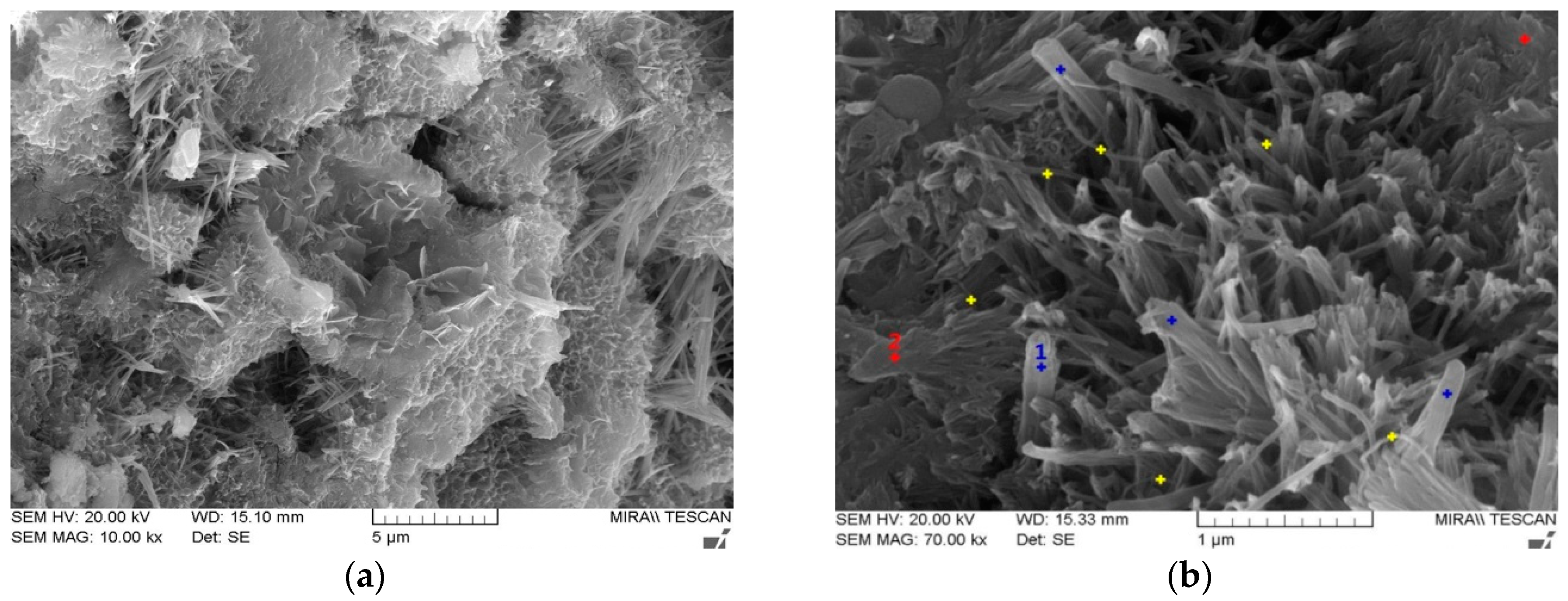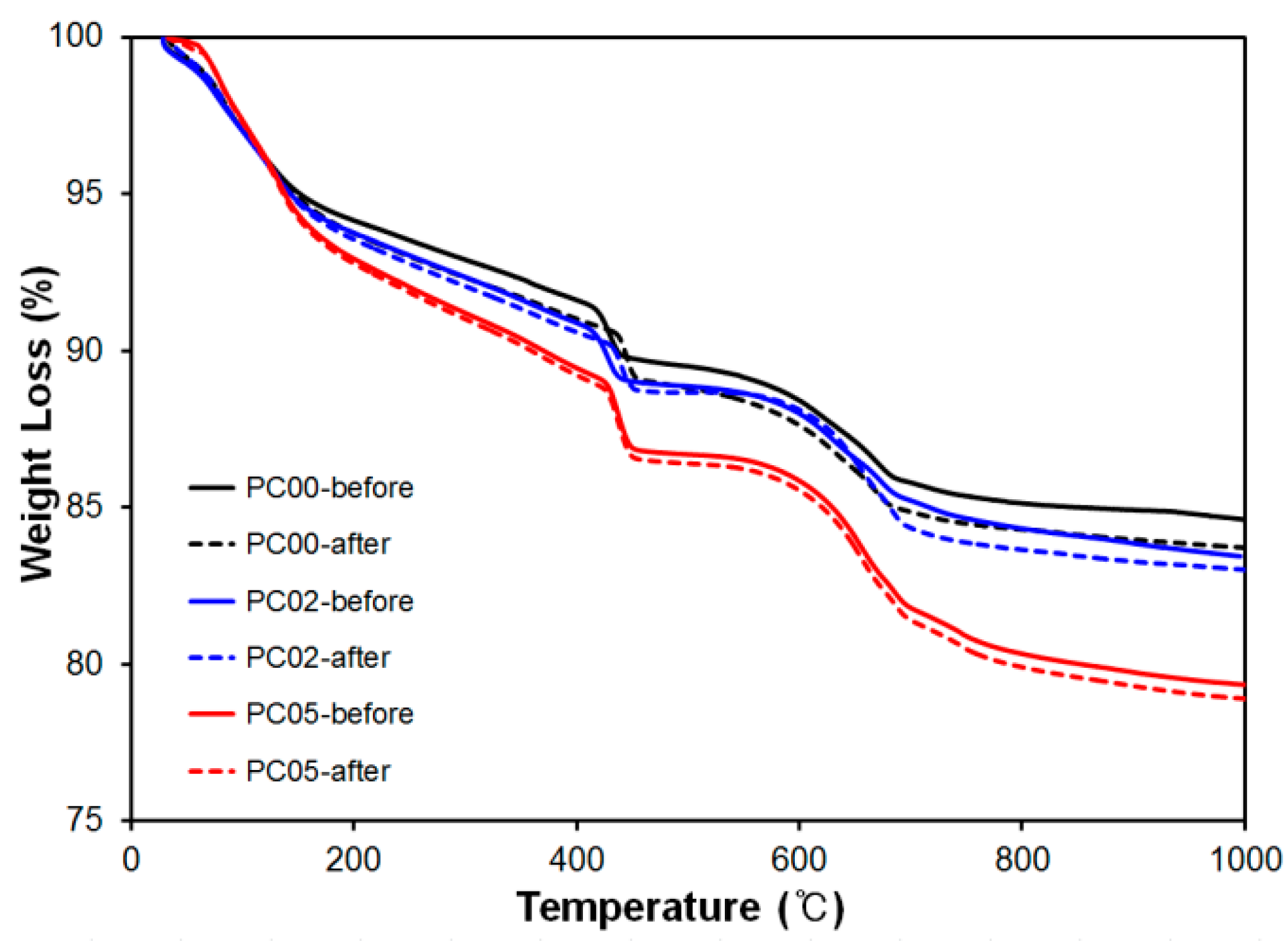2.1. Materials
In order to evaluate the effects of MWCNT additions on the chemical and mechanical properties of cement paste and mortar, 2% concentrated MWCNT solution, which evenly disperses in solutions with high-range water reducer, was used. In the experiment, water was used as the main solvent of the MWCNT solution, with a dispersing agent for effective MWCNT dispersion according to the manufacturer, Ditto Technology from South Korea. The viscosity of the MWCNT solution was 9.0 mPa·s, measured by Brookfield DV-II using an S-18 spindle at a speed of 100 RPM.
The MWCNT solution was placed in an oven at 105 °C to evaporate the water and obtain the image of MWCNT strands using SEM, as shown in
Figure 1. Average diameter and length of the MWCNT strands were 20 nm and 1.5 μm, respectively.
A Blaine surface area of 358 m
2/kg and OPC density of 3.15 kg/m
3 were used in the experiment. A Bogue calculation of the OPC determined the composition to be 44.7% C
3S, 25.0% C
2S, 5.0% C
3A, and 11.9% of C
4AF by mass. The FA used was produced in South Korea, and its fineness and density were 410 m
2/kg and 2.29 kg/m
3, respectively. The chemical and physical properties of the binder materials are provided in
Table 1 and
Figure 2.
2.2. Mix Proportions
The mix proportions are provided in
Table 2. The binders used consisted of 80% OPC and 20% FA. Poly-carboxylate based superplasticizer, with a binder ratio of up to 0.4% by weight, was utilized to improve the workability of the cement paste and mortar specimens due to the low water-to-binder ratio (0.28).
The proportion of binder to aggregate was 0.5 for the mortar mixtures. The aggregate used in this study, ISO standard sand, were natural and fine, and consisted of round particles with more than 98% silica contents. As shown in
Table 2, the paste mixtures were named as “PC-” with various amounts of MWCNT contents, ranging from 0 to 0.5% to binder mass. “PC00” is the paste label of OPC and FA without MWCNT, and “PC05” indicates 0.5 mass% of MWCNT were added in binders to cast paste specimens for the experiments. In order for water-to-binder ratio to be 0.28, extra water was added in the mixture. This is because MWCNT solution contained 2 wt% of solid contents. The “MC-” mixtures were identical with the “PC-” mixtures, except for the additions of ISO sand.
The mixing procedures for the production of paste and mortar specimens were similar to that specified by ISO 679. All binders were placed and pre-mixed in a 5-L bowl for 30 s with the automatic mortar mixer. Then, MWCNT solution and additional water were applied and mixed in the bowl for an additional 30 s at a low speed, 140 RPM for rotating and 65 RPM for revolving.
Subsequently, 120 s of high-speed mixing, 285 RPM for rotating and 125 RPM for revolving, was performed to produce paste specimens for microstructure analysis. In order to evaluate mechanical properties, durability, and thermal conductivity of the mixtures, ISO sand was added to the fresh paste specimens by mixing at high speed for another 120 seconds.
2.3. Test Methods
Compressive and flexural strength tests were conducted according to ISO 679 using three prismatic specimens with dimensions of 40 mm × 40 mm × 160 mm [
19]. After 24 h of curing in a chamber at (21 ± 2) °C and (92 ± 5)% R.H., all specimens were demolded and placed in water containers at (21 ± 2) °C. The strength tests were performed at the ages of 3, 7, 28, 56, and 91 days to observe enhanced strength development.
The hydration heat flow and cumulative heat generated from all paste mixtures containing MWCNT were measured using a TAM-Air isothermal calorimeter. The calorimeter, which was twin-type (sample and reference) and designed to use 20 mL glass ampoules, was capable of measuring eight samples simultaneously. Approximately 4.5 g of paste mixtures were filled in the ampoules, measured on a balance, and placed into the calorimeter. The heat flow was recorded for 7 days and the calorimeter was kept at a constant temperature of (23 ± 1) °C during the experiment.
For SEM image analyses, the samples at 28 days were crushed and dried for 24 h at 40 °C. The samples were carbon-coated and investigated under high vacuum conditions in a Tescan Mira LMH microscope for SEM-EDS analysis. An EDS detector was used to determine the elemental composition of the samples (Quantax EDS, Bruker) with an active analysis area of 30 mm2. The resolution of the equipment was 1 nm per 30 kilo-volts to detect nano-materials in the cement composites.
Mortar specimens were cast in 50 mm-sized cubic molds, in which two sheets of stainless-steel (SS) wire mesh, used as electrodes, were embedded. The SS wire meshes were 45 mm wide and 70 mm high, rectangular in shape, and designed for heat generation. The paste cover for the SS wire meshes were secured with 10 mm distance, and thus, the distance between two electrode sheets was 30 mm.
One of the wire meshes was connected to the power supply as the positive electrode (cathode), and the other mesh was attached as the negative terminal (anode), as shown in
Figure 3. CNT-cement composites are expected to be electrical materials because of the high conductivity of CNTs compared to that of ordinary cement composite. The initial voltage applied to the specimens for the heat generation experiment was 200 V. It took differing time periods to reach the highest temperature of each paste specimen.
Furthermore, temperature data in the center of cube specimens were obtained by embedding thermocouples during the casting of fresh mortars. The thermocouples were directly connected to a data logger to measure the temperatures in real time (
Figure 3). Elevated temperature data were utilized to calculate the thermal conductivity of CNT-cement composites by observing the difference between ambient temperature inside the specimens and the peak temperature during the experiments, and the results are provided in
Section 3.5.
Thermal gravimetric analysis (TGA) via Rigaku Thermo Plus EVO II was used to observe the mass changes in CNT-cement composite pastes and obtain information on some components in CNT-cement hydrates, such as calcium hydroxides and calcites. CNT-cement composites were crushed and ground to prepare powder samples to pass the 150-μm sieve.
Ten milligrams of samples were loaded in the alumina pan to measure mass changes from ambient temperature to 1000 °C. A temperature rate of 10 °C/min was applied to the sample with 300 mL/min of N2 gas in order to prevent oxidation or carbonation during the test. Furthermore, an experiment was conducted to investigate the phase changes in before-and-after thermal conductivity and evaluate if the CNT-composites for heat transfer on-site would be promising and reproducible. TGA was conducted using reference samples, which were cured for 28 days, and the samples obtained after thermal conductivity experiments.
